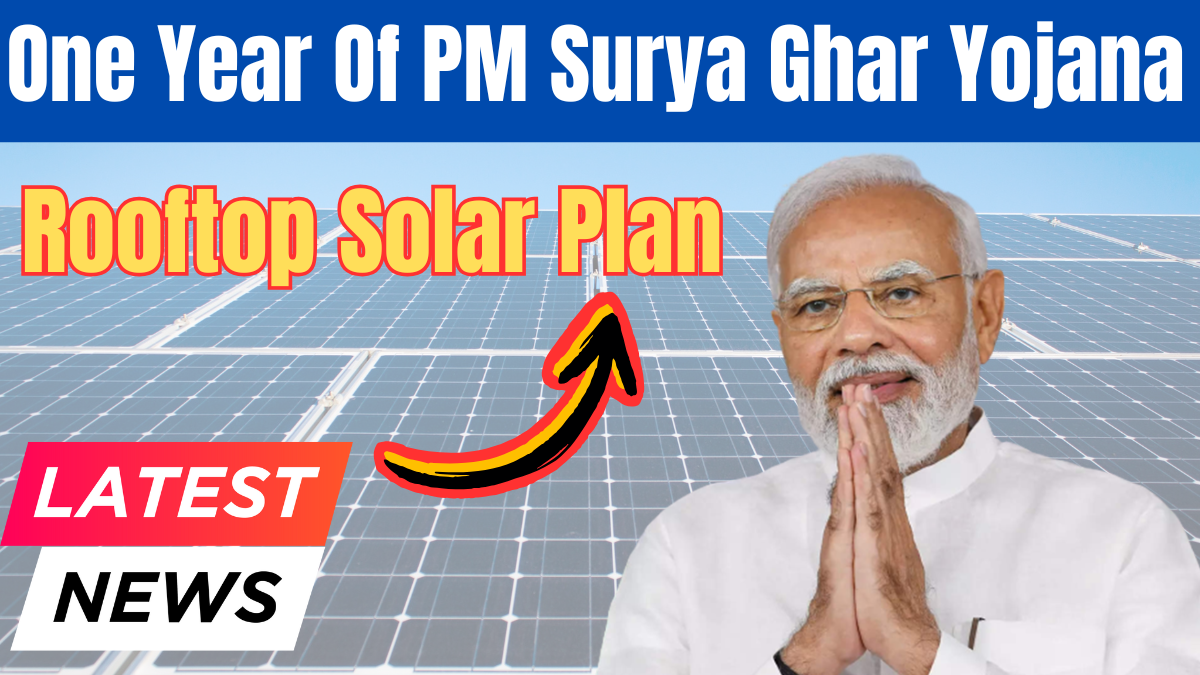As India moves towards greater adoption of solar energy, the PM Surya Ghar: Muft Bijli Yojana completes its first year on February 13, 2025.
Launched by Prime Minister Narendra Modi on February 13, 2024, the scheme aims to provide free electricity by subsidizing rooftop solar panel installations.
With a goal of covering one crore households by 2027, the initiative has made significant progress, helping households reduce energy costs while promoting renewable energy.

What Has Been Achieved So Far?
Increase in Solar Installations
According to official data as of January 27, 2025:
- 8.46 lakh households have installed rooftop solar systems under the scheme.
- The installation rate has increased tenfold, now averaging 70,000 installations per month.
The sharp rise in adoption suggests growing public awareness and affordability, making solar energy a more viable option for households.
Government Subsidy Disbursements
A key factor in this rapid expansion is the subsidy structure, which covers up to 40 percent of installation costs.
- Total subsidies disbursed: ₹4,308.66 crore
- Number of beneficiaries: 5.54 lakh households
- Average subsidy per household: ₹77,800
This financial support has enabled middle-class and lower-income families to invest in solar energy and reduce their dependence on conventional electricity sources.
Which States Have Adopted Rooftop Solar the Most?
States Leading in Solar Installations
Regions with high solar potential have recorded the fastest adoption rates, with Rajasthan, Gujarat, and Madhya Pradesh leading the way.
Additionally, urban areas with high electricity tariffs have also seen strong participation as homeowners look for ways to cut down their power bills.
How Many Households Are Receiving Free Electricity?
Government estimates indicate that:
- 45 percent of beneficiaries now receive zero electricity bills based on their solar power generation.
- Households with higher solar panel capacity have reported substantial reductions in their monthly electricity expenses.
Economic and Environmental Impact of the Scheme
Apart from individual cost savings, the scheme is expected to:
- Save the government ₹75,000 crore annually by reducing electricity subsidies and dependence on fossil fuels.
- Lower carbon emissions, supporting India’s commitment to renewable energy and sustainability goals.
By decentralizing power generation, the initiative is helping reduce pressure on national grids while ensuring affordable and sustainable energy access.
Model Solar Villages: Expanding Solar Power in Rural India
A unique feature of the PM Surya Ghar Yojana is the Model Solar Village program, which aims to:
- Establish one solar-powered village per district.
- Provide ₹1 crore funding to the village with the highest distributed renewable energy capacity.
To qualify, a village must:
- Have a minimum population of 5,000 (or 2,000 in special category states).
- Demonstrate high solar adoption levels over a six-month evaluation period.
This initiative is expected to serve as a blueprint for rural electrification, reducing dependence on traditional power sources in off-grid regions.
Future Targets and Expansion Plans
The government has set aggressive targets for the coming years:
| Target Date | Total Installations |
|---|---|
| March 2025 | 10 lakh households |
| October 2025 | 20 lakh households |
| March 2026 | 40 lakh households |
| March 2027 | 1 crore households |
To meet these goals, installation rates need to be scaled up significantly in the next few years.
Key Takeaways
- 8.46 lakh rooftop solar installations completed in the first year.
- ₹4,308.66 crore disbursed in subsidies, benefiting 5.54 lakh households.
- 45 percent of users now receive zero electricity bills based on solar generation.
- Model Solar Village initiative aims to bring renewable energy to rural India.
- Target: 1 crore solar installations by March 2027, requiring increased public participation and faster implementation.
The PM Surya Ghar Yojana has made notable progress, but achieving its long-term goals will depend on streamlined execution, improved financing accessibility, and wider public awareness.
FAQs About PM Surya Ghar Yojana
1. What is the objective of the PM Surya Ghar Yojana?
The scheme aims to install rooftop solar panels on one crore households by 2027, providing free electricity and reducing dependence on fossil fuels.
2. How many households have benefited so far?
As of January 27, 2025, 8.46 lakh households have installed rooftop solar panels under the scheme.
3. What is the government subsidy for solar panel installation?
The government provides up to 40 percent subsidy, with an average grant of ₹77,800 per household.
4. Which states have the highest rooftop solar adoption?
Rajasthan, Gujarat, and Madhya Pradesh are leading in rooftop solar installations.
5. What is the Model Solar Village program?
This initiative provides ₹1 crore in funding to the village with the highest solar adoption in each district, promoting rural energy self-sufficiency.
6. How much money is the government saving through this scheme?
The initiative is projected to save ₹75,000 crore annually by reducing electricity subsidies and traditional power generation costs.
7. What are the upcoming targets for solar installations?
The government aims to achieve 10 lakh installations by March 2025 and one crore by March 2027.
8. How can homeowners apply for the scheme?
Eligible homeowners can apply through the official government portal, where they can find guidelines on installation, subsidy disbursement, and approved vendors.
Final Thoughts
The PM Surya Ghar Yojana has laid a strong foundation for India’s rooftop solar expansion, helping households lower electricity costs while promoting renewable energy adoption.
With ambitious goals ahead, the success of the scheme will depend on continued public participation, policy support, and efficient implementation.
Click here to know more.
Sachin is a seasoned educator and writer with extensive experience in the field of education. With a deep passion for fostering learning and intellectual curiosity, he has spent many years working across various educational settings, from schools to higher education institutions. His writings often focus on the evolving landscape of education, highlighting innovative teaching methods, the integration of technology in learning, and the importance of personalized education. Sachin’s expertise and commitment to the betterment of education have made him a respected voice in the field, inspiring both students and educators alike.